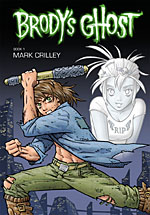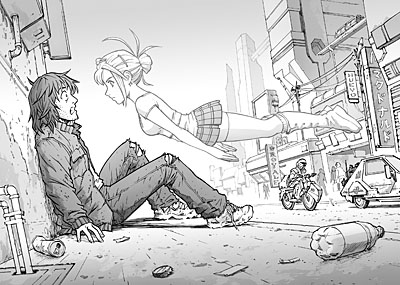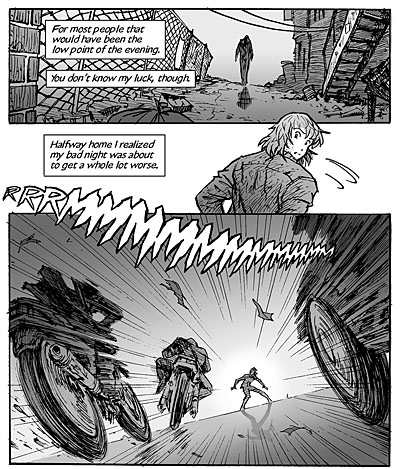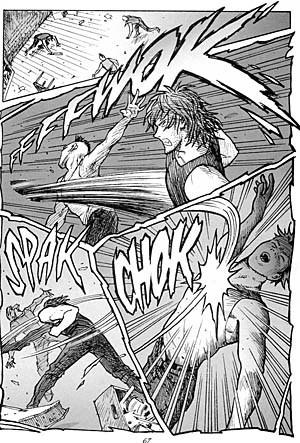 By Mark Crilley
By Mark Crilley
96 pages, black and white
Published by Dark Horse
New comics from Mark Crilley are always a reason to celebrate, as anyone who’s read Akiko or Miki Falls well knows. So ever since we got some teaser stories in MySpace Dark Horse Presents, I was looking forward to his new series Brody’s Ghost. And right off the bat, I found that this series was a little different from Crilley’s previous works; not just in terms of having a male protagonist, but its overall feel and its pacing. It’s an interesting shift for Crilley, and after two volumes I feel safe to say that it works well for him.
On the surface, Brody’s Ghost has an easy enough premise; slacker Brody discovers the hard way that he can see ghosts and has psychic powers, and is pulled into helping the deceased Talia try and find a serial killer so that she can go to Heaven. But with a third of the story now complete, Crilley’s revealed enough additional information to show that this is hardly a one-note story. As strange as it sounds, part of the thing I like about Brody’s Ghost is the 96-page format. It’s a great size for a serial comic; it gives Crilley room to tell an extended chunk of story that isn’t crammed into a 32-page comic that demands much more frequent cliffhangers and resolutions, but at the same time is able to show up on a more regular basis than if Crilley had to produce 250-page volumes before publishing.
 Crilley’s used the first two volumes of Brody’s Ghost to make each a definitive segment of Brody’s life. The first volume is Brody’s awakening into there being more to the world around him. It’s a story of initial discovery, both for his psychic gift as well as the presence of ghosts. Crilley supplements a lot of this opening chapter with details on Brody’s life in general. He’s not at the bottom of the heap, but he’s not exactly on the top of the world either. Aimless is probably the fairest descriptor to use, as Brody meanders through life and scrapes together enough to maintain his current existence, but nothing more. It’s not necessarily that Brody’s content with where he is, but rather Crilley paints the picture of someone unmotivated. And so, with that in mind, Crilley knocks Brody down hard, so that we can see him pull himself back up.
Crilley’s used the first two volumes of Brody’s Ghost to make each a definitive segment of Brody’s life. The first volume is Brody’s awakening into there being more to the world around him. It’s a story of initial discovery, both for his psychic gift as well as the presence of ghosts. Crilley supplements a lot of this opening chapter with details on Brody’s life in general. He’s not at the bottom of the heap, but he’s not exactly on the top of the world either. Aimless is probably the fairest descriptor to use, as Brody meanders through life and scrapes together enough to maintain his current existence, but nothing more. It’s not necessarily that Brody’s content with where he is, but rather Crilley paints the picture of someone unmotivated. And so, with that in mind, Crilley knocks Brody down hard, so that we can see him pull himself back up.
That’s where the second (and current) volume of Brody’s Ghost moves, the rebuilding of Brody into the hero of our piece. It’s a familiar rung in a hero’s journey, as Brody not only learns how to use his inborn talent but also trains and pushes himself into becoming something greater than he previously was. With the 96-page count, Crilley is able to present an extended training sequence here, and while at first I found myself wondering just how long it would go, before long I began to appreciate the attention Crilley was paying to this part of the story. It makes his confrontations at the end of the book—both physical and emotional—much more believable, because you can see the effort he’s put into getting there. With each trial and decision he’s made, he’s reshaped himself into someone better, and it’s a satisfying journey to watch. When Brody finally talks to Nicole at the end of Volume 2, it’s a much different person than the one who tried to talk to her in the first volume. You get the impression that Brody is now someone who could actually take on the dreaded Penny Killer, and that his transformation isn’t temporary.
 The supporting cast and setting of Brody’s Ghost fleshes out the story, and it’s an interesting set of choices. I’m so used to Crilley’s comics starring strong female characters that it feels a bit odd for Talia to be more of a secondary presence. She’s still the one who drives the book forward (without her, none of this would happen), and for the first two volumes she’s the motivation for Brody to get strong enough to track down the Penny Killer. She’s still a bit of an enigma, though; we don’t know why she needs to perform a large act of good to be let into Heaven, for instance, and aside from being insistent she’s not as fleshed out as she could be (no pun intended). Right now I feel like Talia is more a function of the plot than a main character, perhaps in part because the first two volumes dealt primarily with Brody’s transformation. Now that the hunt for the Penny Killer is on, though, I’m hoping we’ll get more of Talia in the remaining four volumes. Then again, Talia’s definitely a larger presence of the book than Kagemura, who as Brody’s trainer, comes across even more so a part of the plot. He’s there to help the transition of Brody, but for now that appears to be his sole purpose. Kagemura’s Japanese heritage both sets him apart and pushes him into a box here; he stands out, but the Japanese spiritual guide is a character archetype we’ve seen in numerous other works. At the same time, I did find myself towards the end of the second volume wishing to have my own Kagemura to help me pare down to the essentials in life, so there’s something to be said for Kagemura.
The supporting cast and setting of Brody’s Ghost fleshes out the story, and it’s an interesting set of choices. I’m so used to Crilley’s comics starring strong female characters that it feels a bit odd for Talia to be more of a secondary presence. She’s still the one who drives the book forward (without her, none of this would happen), and for the first two volumes she’s the motivation for Brody to get strong enough to track down the Penny Killer. She’s still a bit of an enigma, though; we don’t know why she needs to perform a large act of good to be let into Heaven, for instance, and aside from being insistent she’s not as fleshed out as she could be (no pun intended). Right now I feel like Talia is more a function of the plot than a main character, perhaps in part because the first two volumes dealt primarily with Brody’s transformation. Now that the hunt for the Penny Killer is on, though, I’m hoping we’ll get more of Talia in the remaining four volumes. Then again, Talia’s definitely a larger presence of the book than Kagemura, who as Brody’s trainer, comes across even more so a part of the plot. He’s there to help the transition of Brody, but for now that appears to be his sole purpose. Kagemura’s Japanese heritage both sets him apart and pushes him into a box here; he stands out, but the Japanese spiritual guide is a character archetype we’ve seen in numerous other works. At the same time, I did find myself towards the end of the second volume wishing to have my own Kagemura to help me pare down to the essentials in life, so there’s something to be said for Kagemura.
 It’s the futuristic, slightly-run-down city of Brody’s Ghost that in some ways feels like the strongest secondary character in the series. Crilley draws a gorgeous city spread in each volume, giving you the sense of a place that’s existed for ages, but has probably seen better days. Crilley doesn’t fall into the trap of making a city look identical throughout its streets; the area where Nicole works looks much more picked up and well-off than the alleyway where Brody is attacked by the L47 gang, for instance, or the older and neglected neighborhood of the Shinshoji Temple. Every time you think you’ve seen the city as a whole, we get another angle of its presence, from the suspended freeways jammed full of commuter traffic, to the boarded up office building taken over by the L47s.
It’s the futuristic, slightly-run-down city of Brody’s Ghost that in some ways feels like the strongest secondary character in the series. Crilley draws a gorgeous city spread in each volume, giving you the sense of a place that’s existed for ages, but has probably seen better days. Crilley doesn’t fall into the trap of making a city look identical throughout its streets; the area where Nicole works looks much more picked up and well-off than the alleyway where Brody is attacked by the L47 gang, for instance, or the older and neglected neighborhood of the Shinshoji Temple. Every time you think you’ve seen the city as a whole, we get another angle of its presence, from the suspended freeways jammed full of commuter traffic, to the boarded up office building taken over by the L47s.
And of course, the people in the book look great. The scene where Brody first meets Talia, for example, is great not only because of how it’s written but how Crilley stages it. From the intense stare doled out by Talia, to Brody’s utterly petrified and wigged-out expression, you get an instant sense of how both characters feel in that moment. Crilley in general is good about telling his story in part through the art; watching Brody’s transformation also shift him from slovenly to put-together is a good visual hallmark of his progress, and the ever shifting face of Talia says more than any words could. Brody’s Ghost is also the most action-oriented comic I think I’ve read by Crilley, and he tackles it with aplomb. I like how he shifts his normally clean, carefully crafted figures into a rougher and jagged style when Brody’s being buzzed by the L47 gang’s motorcycles, for instance; it makes a static image actually feel fast and in motion, as well as a little dangerous.
Brody’s Ghost is a fun book so far; with a planned six volumes, we’re far enough into the story now to get a strong sense of where it’s going, and at the same time I appreciate that each book has ended with a strong lead-in to the next installment. And of course, with each volume already having a spine, a nice cover stock, and crisp paper, there’s no need to "wait for the trade" here; it already looks good on your bookshelf. Crilley fans, I suspect, don’t need any nudge into picking up Brody’s Ghost. For everyone else, though? This is a great way to spend an afternoon, and I’m eager to see what the next step in Brody’s journey as a hero will be. Good stuff.
Purchase Links (Vol. 1): Amazon.com | Powell’s Books
Purchase Links (Vol. 2): Amazon.com | Powell’s Books
